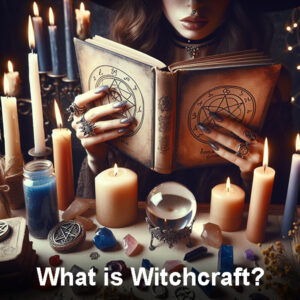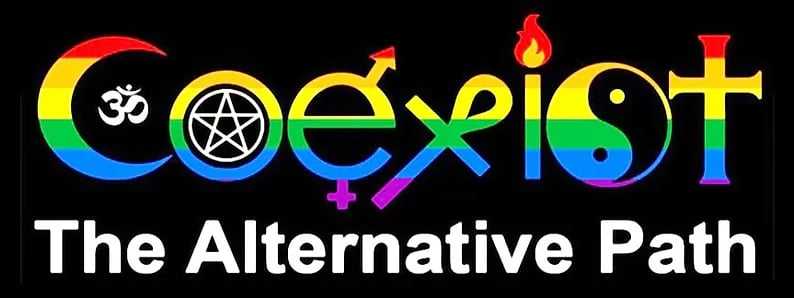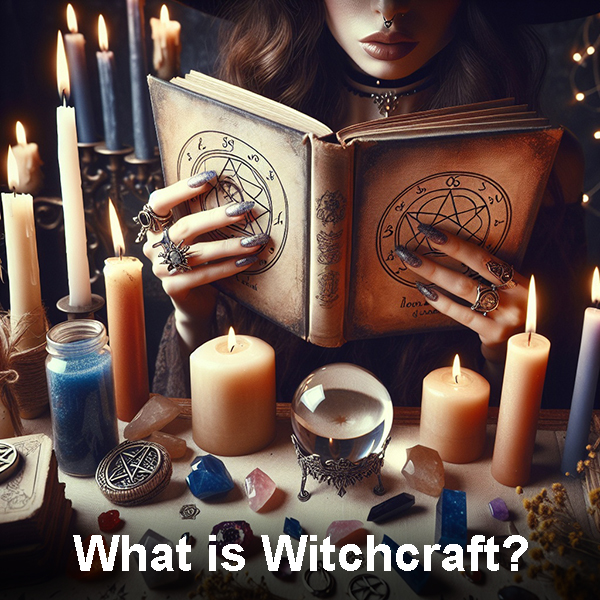What is Witchcraft but Science and Art?

Ah, what is witchcraft? That mysterious, misunderstood art that seems to be everywhere yet nowhere at the same time. Depending on who you ask, it’s either the epitome of evil or the key to unlocking the universe’s secrets. Frankly, it’s neither. But that doesn’t make for a very good headline, does it? So let’s dive in, bust some myths, and clear up this little bundle of confusion that everyone loves to gossip about.
We have many occult books about witchcraft in our physical store, come visit! Connect with us for more on Instagram, Facebook (Meta) or TikTok. We also offer in-person readings, or if needed online tarot readings.
You shouldn’t let the word “occult” scare you, it simply means anything outside of the big three religions.
Witchcraft is not a new concept. It’s been around as long as humans have. Since day one, people have believed there is an energy or life force that flows through everything. All things, animate and inanimate, have a kind of pulse. It’s not some fairy tale idea invented by an overactive imagination. This belief has been universal across cultures and civilizations. Why? Because it’s true. Just ask any witch.
In short, witchcraft is a practice that taps into these energies. It doesn’t come from some dark place, and it’s definitely not limited to anything evil. It’s about using the natural world around us—herbs, crystals, the elements, the moon, the stars—to manifest change. It’s not about summoning demons, casting curses, or talking to ghosts, though I’m sure Hollywood would love you to believe that. But what do they know? Can and does that happen? Yes, it does, but you should know that in some cultures not all demons are “evil” but helpful. And talking to spirits, well it is lovely to catch up with old friends. My point is, Hollywood for the most part has given us a bad rap in an effort to make box-office gains.
You can’t really define witchcraft as “good” or “evil.” That’s a moral judgment, and morality is a very personal thing. A witch is neither inherently virtuous nor wicked. It depends entirely on the individual. So, let’s forget those ridiculous stereotypes, shall we? Witchcraft is much more than what you’ve seen in a movie. It’s ancient, diverse, and remarkably down-to-earth—literally.
The Myths of Good and Evil
Here’s the thing about good and evil: they’re subjective, aren’t they? What’s “good” to one person might be “evil” to another. And let’s not forget about the obvious truth that what most people think they know about witchcraft is based on myths, movies, and a healthy dose of fear. The idea that witchcraft is inherently dark and malevolent is just silly. But here we are, still battling centuries of misinformation.
Take the world’s major religions, for instance. They’ve all condemned witchcraft at some point, largely out of bigotry. It was, after all, much easier to control people if you labeled something “evil” just because it was different from your belief system. Think about it: if you don’t understand something, or if it threatens your position of power, the quickest route to control is to vilify it. Historically, this has been done to witches, pagans, and anyone who didn’t fall in line with the dominant religious doctrine.
Let’s face it: Christians, Jews, and Muslims have been extremely effective at branding anything that didn’t fit their narrative as “the devil’s work.” And when you look at the history of witch trials—burnings, drownings, tortures—you start to see that the real evil might just be in the hands of those doing the condemning, not those being condemned.
Please don’t confuse witchcraft with Wicca, they are two different but related things. Not everyone who is Wiccan practices witchcraft and not every witch is Wiccan. Wicca is a modern religious belief system with many laws to follow. I roll with what is natural, just a plain old witch. Wicca vs Witchcraft, what’s the difference?
Who Are the Real Witches?
Okay, let’s clear something up: witches are not the cackling, wart-nosed old women you’ve seen in fairy tales. We are not the creepy, sinister types stirring cauldrons and casting spells to curse the innocent. Sorry, not sorry, but that’s not the reality.
In truth, most witches are healers, teachers, and protectors of the earth. We work with the energies around us and recognize the importance of nature in all its forms. Herbs, crystals, trees, animals—they’re not just tools or objects to us. They’re vital components of a living, breathing ecosystem that we hold dear. We have knowledge of how to work with these energies in a way that’s respectful and beneficial to both us and the planet.
Contrary to what some people might want to believe, witches don’t go around trying to control the world or harm others. In fact, many of us live by the principle of “harm none.” In other words, we don’t mess with people’s free will. We don’t go out looking for trouble, and we certainly don’t go out of our way to create it. So, no, we’re not the evil overlords some would have you think.
In fact, in many ways, we are guardians of the Earth—keepers of its secrets and protectors of its balance. We understand the delicate relationship between human beings and the planet, and we’re committed to ensuring that balance is maintained. How many times have you heard of a witch planting a garden or offering herbs to a sick friend? How many “evil” witches do you know who run sustainable farms or care for animals in need? Exactly.
It’s Not About Religion, It’s About Personal Power
One thing that gets under my skin is how people tend to confuse witchcraft with religion. Sure, some witches are religious, but it’s not about religion—it’s about personal power. You don’t have to follow any particular god or goddess to practice witchcraft. You don’t need a fancy temple or a giant book of rules. It’s about understanding and harnessing the energies that are already around you.
If you want to get all scientific about it, you could argue that witchcraft is a sort of “energy work.” Another thing that functions this way is Chakra and Reiki healing. We work with energies of the natural world—whether it’s through plants, the movement of the stars, or the cycles of the moon. This isn’t some mystical, “feel-good” nonsense. There are scientific studies that prove the energy we interact with is real. We’re constantly in a dance with the natural forces around us, and witchcraft is the practice of learning how to move to the rhythm of those forces.
Witches don’t claim to be infallible or all-knowing. But we do understand energy in ways that others often overlook. It’s a skill, an art, and yes, a science. If you think this is all just “witchy woo-woo,” I suggest you take a look at some of the latest scientific articles. There’s a lot more overlap between the “magic” of witchcraft and the science of energy than most people care to admit.
Witchcraft: A Diverse and Inclusive Practice
One of the most fascinating things about witchcraft is how diverse it is. You could spend your entire life studying different traditions—Celtic, Norse, Voodoo, Hoodoo, African, and even Christian witchcraft. Yes, you read that right. There are witches who identify as Christians. So much for the “devil worshiper” narrative, right? Ancient Hebrews had magic too, King Solomon of the bible was actually deep into necromancy and working with spirits. Ever read The Greater or Lesser Keys of Solomon? I advise people to have a heart for truth when reading religious books, not a heart for what they want to hear. Do they even understand a historical book’s evolution? Cultures conquering cultures and assimilating beliefs, all of them trying to get it under one roof. That’s a lot of revisions and inevitably a lot of contradictions. Nature doesn’t contradict itself and that’s our religion.
In fact, witchcraft has no universal dogma. It’s not a single path or a single tradition. It draws from countless cultures and histories, and it continues to evolve with the times. Some witches practice ancestral traditions, while others are modern-day seekers looking for new ways to connect with the universe. From South American shamanism to Roman and Russian folk magic, witchcraft is an umbrella that covers a wide variety of spiritual and practical practices.
When you really think about it, witchcraft is just another way of working with nature, with intention. It’s like cooking—using what’s available and making it work for you. Herbs, essential oils, crystals and candles, stars and moons—all ingredients in an age-old recipe for balance, healing, and personal empowerment. It’s creative, hands-on, and deeply personal.
What Witchcraft Has In Common with Cooking
Speaking of cooking, think of witchcraft like a culinary art. It’s not a one-size-fits-all practice. Every witch is different, just like every chef has their own style in the kitchen. Witches work with herbs; others focus on crystals. Some use astrology and the phases of the moon to guide their practices. Some are deeply spiritual, while others are more pragmatic, using their craft for healing or problem-solving.
Witchcraft, like cooking, is about combining the ingredients that work best for you—whether that’s the right herbs for an illness or a ritual to attract abundance. And, just like cooking, it takes time and practice to get it right. There’s no universal “recipe” for success—just like there’s no universal definition of witchcraft. It’s what works for you, and it’s meant to be shared and enjoyed, not hoarded or controlled.
Conclusion: Let’s Stop the Hating
So, what is witchcraft? It’s part science, part art, and entirely misunderstood by those who judge it based on preconceived notions. We are not evil. We’re not here to destroy the world or summon demons. We’re healers, teachers, and guardians of the Earth, working with natural energies to make life better for ourselves and those around us.
Just like the hundreds of denominations of Christianity, witches are diverse. We come from all walks of life and all backgrounds. And just like any religious group, we are capable of kindness or cruelty, good or bad. So, instead of throwing stones from your glass house, how about you get to know a witch before you judge? Maybe you’ll find that we’re not so different after all.






As a newer witch I love this! I may be hesitant to try new things, but I love making them my own once I do. I learned not too long ago, before I knew I was a witch, that when cooking (the mundane way)you don’t necessarily have to follow a recipe to the letter and you can improve on it. I seem to do that in my practice as well. I love that freedom after knowledge!! I’ll have a “recipe”, but with a little thought and research I can adapt it for my exact needs. I love crystals more every day!! I do enjoy the ride I’m on now a bit more.
Exactly – I don’t mess with a “recipe” once it’s perfect or performs beautifully – but sometimes a twist is called for, or if something new, reworking the “recipe” until it suits. In the end, make your magic your own. Sure, stick to principles and what works, but now add those personal layers and touches. 😉 Blessings.
I think the real witches are the ones who can control the weather. Forget about personal power, give me someone who can make it rain on command! Lets see Mother Nature bow down to that witchcraft!
Nature doesn’t bow to anyone. However, I guess you have never heard of weather magic? It is real, and achievable with time and patience
I use weather magic a lot, and often it’s just enough for a break in the rain so my dogs can go potty outside without getting soaked. Or, if we’re having a gathering, weather magic for a decent evening is always in order. It doesn’t work like you think it does. I appreciate your comment and opinion, but appreciate a respectful tone a bit more, just sayin. Thanks and Blessed Be.
I find the idea of witchcraft being a blend of science and art intriguing. It challenges traditional beliefs and opens up new perspectives. Who knew it could be so empowering and fascinating? 🧙♀️✨